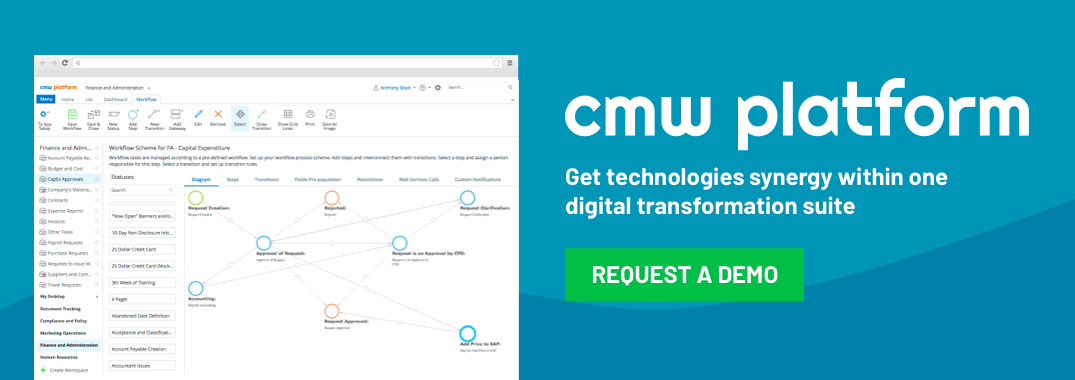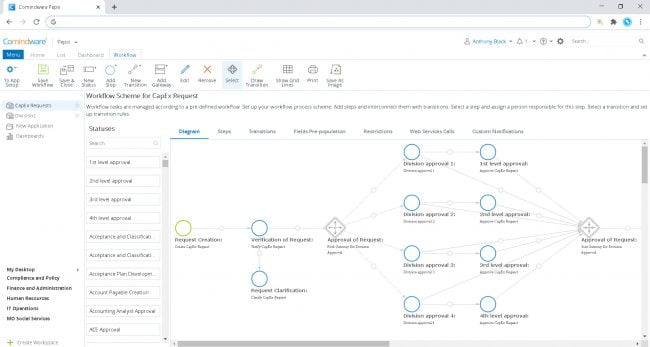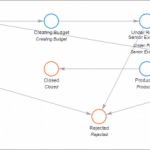Complete Basics of Business Process Management (BPM) Software
Tuesday, April 13, 2021 / Updated: July 29, 2024
In today’s world of business, it isn’t enough to have an excellent product or idea, or a well-run company, you also have to provide timely, accurate, and actionable information that allows a company to plan for the future. This means that business professionals must be flexible to new techniques and technologies that can better help them stand apart from the proverbial crowd and keep their business running as efficiently and smoothly as possible.

Table of Contents
What is BPM?
Business process management (BPM) is a set of methods that are used to model, measure, analyze, and perhaps, even automate various processes within a given business. In essence, it refers to the methods people use to develop, monitor, and manage different processes.
This can be done in many ways and can be rigidly structured or highly variable. While this doesn’t have to include the implementation of new technologies, it most often does in the form of automation software or machine learning and AI-based software that can help improve efficiency and reduce errors or redundancy.
The basic idea is to have a proper model of a given business process in order to streamline and automate the process so as to relieve employees of repetitive data entry tasks and to maximize the efficiency by which the business operates.
There is a business process lifecycle that includes designing a given process, modeling potential outcomes, executing the implementation of said process, monitoring the success or failure of said process, and optimizing the process when new information is provided that shows where weaknesses may lie.
All BPM is designed to do is to help improve the usefulness and applicability of processes and to ensure that they run smoothly, efficiently, and provide useful metrics and data that can be used to improve processes.
BPMS (BPM software): What’s Inside?
As we noted above, if you utilize automation technologies or other software, you can design a detailed, step-by-step list of every step within a given process. By mapping out the various steps involved in managing and implementing a process, you are likely to see areas where the process can be improved, find areas that need to have a troubleshooting session, and find ways to make the process more efficient.
When using BPM software, there are four steps that you will take and each of these is important. These steps are modeling, automating, managing, and optimizing a process. It will be helpful for us to take a look at each of these steps in turn.
Modeling
This is one of the most important steps in the business practice management field. This is where a process is broken down into individual steps. This will involve making assumptions about the use of time or resources, which can then be tried out and improved if necessary.
Once a process has been fully mapped, you will have a better idea of what type of resources and time will need to be dedicated to a process. Having a detailed breakdown of the process can also show you ways in which you can better streamline the process and can also show you where potential issues might come into play.
Automating
Repetitive tasks are not much fun for employees and they leave too much room open for human error. With the powerful new software (BPA), processes that were managed manually can be automated. This frees up human resources for other projects and tasks that require more sophisticated and complex thinking.
We also know that a human being is more prone to mistakes than a machine and a machine can do rote tasks like repetitive data entry far faster than a human can. There are tons of ways that you can easily implement automation functions into your business processes.
Say, for example, you have a form on your website that is used to collect various pieces of customer data. This process can easily be automated using workflow automation software and can provide advanced metrics in addition to saving employees tons of time that would otherwise be spent on repetitive data entry or data collection.
Management
Once a process is implemented, this doesn’t mean the work is done. There are always factors that escaped notice in modeling. Sometimes issues aren’t found until a process goes live and actual customers or employees are interacting with the new software.
You can gain really important insights and understanding during the management process. The data can be used for strategic planning and setting business goals, it can be used to find ways to better design a process, and it can also help you see what processes are effective and which need work.
 Comindware Tracker empowers people without coding skills to design and automate workflows with ease.
Comindware Tracker empowers people without coding skills to design and automate workflows with ease.It is important to understand that no matter how well your initial model was created, there are going to be factors that weren’t considered or that don’t come up until a process is live and has been implemented. This is just part of the process of developing better and more efficient processes for the future.
This part of BPM is incredibly important as it gives you access to invaluable data that can be used in planning and setting goals. It can also show you how effective or ineffective a given process is and this will give you the opportunity to improve the process and provide a better experience for all parties involved.
Optimization
You get a lot of information and data during the management and monitoring part of BPM and this information is incredibly valuable for shaping future decisions and coming up with ways to better optimize processes that are already in use.
Looking at the data provided through monitoring and management, as well as taking into account any issues or problems that have been found in a given process will give you the tools and information you need to make necessary changes that will improve the efficiency and value of the process.
Sometimes we will find redundancies, errors, or holes in our process that are bogging things down. At this stage in BPM, you can take the information gleaned during the other steps in the process to improve the process and troubleshoot problem areas for improvement as well.
Optimization is an ongoing process that really never ends. Things change, problems come up, we find inefficiencies, and our job during this part of the BPM process is to take all the information we are given and turn that into actionable and useful tips or ideas on how to improve part of all of a given business process.
What are the benefits of BPM software?
Using BPM software, tools, or strategies confers many benefits to a company. These tools can help the company better reach its business goals and create more value in the processes they utilize. The key goal of BPM is to create efficient, useful, and workable processes that provide value for the customer and that make management and optimization a priority.
With BPM, you can focus on the lifecycle of a business process and better see how you can use technology and other strategies to improve the efficiency and value of the process for all parties involved.
These tools allow for flexibility, which is important for a future with unknown technologies and that is ever-changing. Today’s business management strategies must be flexible and nimble, able to be adapted to the changing needs of customers and businesses, as well as the use of new technologies.
Along with the invaluable data and future scaling that is made possible by solid BPM strategies, other benefits include:
- The integration of third-party technologies into the web of already used technologies, creating more options, choices, and different management controls that can be scaled as needed.
- Reduce the amount of money that is spent on redundant data entry and other processes that could be automated at a far less expensive cost. Cost reduction can also help to facilitate growth and make it possible to reach strategic planning goals.
- BPM gives employees in various departments access to and a voice in the development of processes and how to fix any problems that may arise. Having more minds involved means you are more likely to get positive contributions and enhance the business value of the entire process.
- Using solid BPM also allows you to be flexible in the face of changes. Laws, rules, norms, and regulations are always changing and so a business process that is static is one that will quickly become obsolete. With flexible BPM, you can easily update your processes in light of new rules, laws, or regulations, allowing you to stay in compliance without having to completely rewrite all your processes.
BPM Software features above basic
When deciding which BPM software suite of tools will work best for you, you will need to take into account the features that are offered within the software suite. BPM and automation tools come in a lot of shapes and sizes, with different features and levels of functionality. These software suites can be expensive, so you want to make sure you are getting a product that provides you with the tools you need before you expend the money. Let’s take a look at some of the most important features in BPM software that you should look for when choosing the best choice for your business.
Visual ToolsOne of the biggest benefits of quality BPM software is the ability to use said software without having a background in IT or a detailed understanding of coding and other backend skills. The idea is that people from various departments can utilize these tools and bring their unique knowledge and understanding of the development of processes. Unless you plan on making IT the exclusive party that will manage BPM, having a software suite that can be utilized, even by those without a ton of technical skill, is a great idea.
Drag and Drop DesignerThis is a bit of a continuance of the above principle. The easier a piece of software is to use, the more people can use it and the more effective it is likely to be. Choosing software that has an easy-to-use interface and utilizes tools like drag and drop features simplifies the process and doesn’t create a steep learning curve for the ability to use it.
MobilityMore and more people work remotely or on the road and for this reason, you may need software that can be easily accessed, regardless of where you are. Cloud-based software solutions can be a great way to implement BPM and allow employees access to the tools, even if they aren’t physically in the building.
Metrics and AnalyticsPerhaps as important as the ability to automate and streamline processes is the data and metrics you get with many of these suites of software. Enhanced data analytics can make compliance reporting and basic reporting far easier than ever before. The information can also show you where inefficiencies or problems may lie, or what processes are working well, and how you can take what you learned from creating one process and apply it to others.
IntegrationMost companies are already using a range of software tools for other parts of their business operation. The implementation of BPM software should not mean that all other software is now obsolete. There are a lot of great BPM tools that can easily be integrated into third-party systems, allowing you to essentially add on tools without having to learn or implement an entirely new operating structure.
AdaptationSome processes will be pretty straightforward and cut and dry whereas others will require flexibility and cannot be rigidly structured. This is where adaptive case management features can be very helpful as they provide enhanced features that give you a range of solutions that can help you better manage unique or non-traditional processes.
Data and Document Management ToolsToday’s business is inundated with more information and data than ever before and is expected to process, analyze, and manage that data as soon as it arrives. With individual people managing data, this is next to impossible and if you can’t work fast, you are likely to be left behind. This is why this is such an important part of any quality BPM software package.
You need to choose software that can handle a large volume of data and can manage it in an effective and efficient way so that it is accessible when and where it is needed. This data can be an invaluable resource for improving business processes and troubleshooting, but it ceases to be useful if it is in a jumbled and unorganized mess.
Role-based ControlsSince security is a vital part of any business process, and many people may need access to the software for a variety of reasons, you want to choose software that has good security protocols. A lot of software allows you to provide access based on roles, giving only advanced access to those employees who need it.
This can help ensure we are following data security protocols and will keep unnecessary parties away from private or sensitive data.
Ability to CollaborateChances are, to get the most out of BPM software, you are going to need parties from a number of different departments to work together to create a solid business process. The ability to collaborate within the software will reduce the problems with communication that are entailed when having to move from platform to platform to perform a task or ask a question.
One-time Process CapabilityWhile much of what you use BPM software for will be more detailed processes, some aspects cannot really be called processes but they are important nonetheless. These smaller projects may still need to be adapted and streamlined and having a suite of software tools that can also help with the management of separate, one-time projects, is also incredibly helpful.
BPM Software evaluation checklist
When choosing the BPM software that will work best for your company and its individual needs, it is helpful to ask yourself a number of questions. These will help you narrow down your options and choose the suite of software that will fit your budget and needs.
- What goals are you trying to achieve by implementing this software?
- How much money are you approved to spend on a suite of software tools?
- Are you looking for on-site or cloud-based BPM solutions?
- Do you want a fully paid version, a free version, software with free trials, or an open-sourced, fully free suite of tools?
- Have you considered all the costs associated with the software such as hosting or monthly fees?
- Are your customers experiencing difficulty with any aspect of your business operation and can these tools solve the said problem?
- How long does it take the software to pay for itself, are there other customers that use the software and have had success?
- What level of technological aptitude do the people who will be tasked with using the software have?
- Can the software be scaled?
- Will you need to train employees on how to use the software and how much effort will this take?
- Have you looked at customer reviews, especially with an eye towards customer support after purchase?
Comindware Tracker difference
Comindware Tracker provides a wide range of tools that will help improve efficiency and allow departments to work more effectively with one another to develop, monitor, and improve a given business process. This software suite provides a variety of tools that will help automate processes, make interconnectedness far more manageable, and improve the efficiency of all processes.
The software allows for:
- setting up workflows without the need for IT help or advanced technological know-how
- easy changes to processes, workflows, and forms
- Outlook-style interface for ease of use
- advanced and unified data and document management solutions
- enhanced analytics for reporting and optimizing workflows and processes
- your choice between on-site or cloud-based deployment solutions
This powerful suite of tools makes it easier than ever before to improve workflow management, automate various processes, and provide for better BPM so as to improve efficiency, provide flexibility, and reduce overhead.
In Conclusion
Business process management (BPM) is an important concept that should be implemented into any company, large or small. BPM refers to the methods or strategies that are used to model, analyze, manage, and adapt a given business process for enhanced efficiency and utility.
Each process a business undertakes involves a series of steps that are required to implement the said process. BPM involves detailing these steps and finding ways to help better streamline these processes, to automate them, and analyze changes to help continue to improve a given process.
In today’s business environment, being efficient and flexible are part and parcel of success. This is why it can be so valuable to implement BPM tools and strategies that will give you better metrics for analysis, improve the efficiency of business processes, and make it easier to comply with ever-changing laws and regulations with far more ease than would otherwise be possible.
BPM software can provide a powerful range of tools that allows a business to optimize, monitor, and adapt a business process based on key metrics and user input. This software comes in many shapes and sizes, with different features, levels of sophistication, and more.
Investing in BPM software is a great way to improve the efficiency of your business and to better prepare you for an increasingly technology-reliant future. It can be helpful to choose software that can be used by the average employee, that features an intuitive interface that has drag and drop features, and other tools that allow those without a ton of IT skill to participate in using the software.
You want to make sure that the software provides high-quality analytics that can provide you with data that will guide actionable changes and allow you to better reach your strategic goals.
More sophisticated software will also have tools that are meant for more flexible, less rigid processes, that cannot be defined in a step-by-step manner, with all elements of the process entailed. This can be really helpful for the future, where flexibility and the ability to alter plans or processes on the fly is so important.
Buying BPM software is an investment, so you want to make sure that you know what it is, what features you are looking for, and what aspects of this technology are most important to you when trying to choose the software that will work best for you. Take a look at your business processes, the people who will be involved in implementing and managing said processes, and this will help guide you towards the right software for the specific needs of your business.



Posted on: in Bpm